Not Just One, But Seven Earth-size Planets That Could Potentially Harbor Life Have Been Identified Orbiting

Not just one, but seven Earth-size planets that could potentially harbor life have been identified orbiting a tiny star not too far away, offering the first realistic opportunity to search for signs of alien life outside of the solar system.
The planets orbit a dwarf star named Trappist-1, about 40 light years, or some 235 trillion miles, from Earth. That is quite close in cosmic terms, and by happy accident, the orientation of the orbits of the seven planets allows them to be studied in great detail.
One or more of the exoplanets in this new system could be at the right temperature to be awash in oceans of water, astronomers said, based on the distance of the planets from the dwarf star.
“This is the first time so many planets of this kind are found around the same star,” said Michael Gillon, an astronomer at the University of Liege in Belgium and the leader of an international team that has been observing Trappist-1.
Continue Reading.
More Posts from The-sleepy-chemist and Others

Giant Centipede - Scolopendra subspinipes
Scolopendra subspinipes (Scolopendromorpha - Scolopendridae) is a really huge and fast growing centipede that can exceed 20 cm in length. They are voracious, strictly carnivores, and also poisonous, feeding mostly on small insects, spiders, earthworms, and other arthropods.
Scolopendra subspinipes is cosmopolitan in tropical and subtropical regions of the world, where these animals serve an ecologically important role as soil and leaf litter predators.
The sting of this centipede reportedly causes intense pain, burning, swelling, and erythema.
References: [1] - [2] - [3]
Photo credit: ©Melvyn Yeo | Locality: not indicated (2013)
Using the Power of Space to Fight Cancer
From cancer research to DNA sequencing, the International Space Space is proving to be an ideal platform for medical research. But new techniques in fighting cancer are not confined to research on the space station. Increasingly, artificial intelligence is helping to “read” large datasets. And for the past 15 years, these big data techniques pioneered by our Jet Propulsion Laboratory have been revolutionizing biomedical research.
Microgravity Research on Space Station
On Earth, scientists have devised several laboratory methods to mimic normal cellular behavior, but none of them work exactly the way the body does. Beginning more than 40 years ago aboard Skylab and continuing today aboard the space station, we and our partners have conducted research in the microgravity of space. In this environment, in vitro cells arrange themselves into three-dimensional groupings, or aggregates. These aggregates more closely resemble what actually occurs in the human body. Cells in microgravity also tend to clump together more easily, and they experience reduced fluid shear stress – a type of turbulence that can affect their behavior. The development of 3D structure and enhanced cell differentiation seen in microgravity may help scientists study cell behavior and cancer development in models that behave more like tissues in the human body.

In addition, using the distinctive microgravity environment aboard the station, researchers are making further advancements in cancer therapy. The process of microencapsulation was investigated aboard the space station in an effort to improve the Earth-based technology. Microencapsulation is a technique that creates tiny, liquid-filled, biodegradable micro-balloons that can serve as delivery systems for various compounds, including specific combinations of concentrated anti-tumor drugs. For decades, scientists and clinicians have looked for the best ways to deliver these micro-balloons, or microcapsules, directly to specific treatment sites within a cancer patient, a process that has the potential to revolutionize cancer treatment.

A team of scientists at Johnson Space Center used the station as a tool to advance an Earth-based microencapsulation system, known as the Microencapsulation Electrostatic Processing System-II (MEPS-II), as a way to make more effective microcapsules. The team leveraged fluid behavior in microgravity to develop a new technique for making these microcapsules that would be more effective on Earth. In space, microgravity brought together two liquids incapable of mixing on Earth (80 percent water and 20 percent oil) in such a way that spontaneously caused liquid-filled microcapsules to form as spherical, tiny, liquid-filled bubbles surrounded by a thin, semipermeable, outer membrane. After studying these microcapsules on Earth, the team was able to develop a system to make more of the space-like microcapsules on Earth and are now performing activities leading to FDA approval for use in cancer treatment.

In addition, the ISS National Laboratory managed by the Center for the Advancement of Science in Space (CASIS) has also sponsored cancer-related investigations. An example of that is an investigation conducted by the commercial company Eli Lilly that seeks to crystallize a human membrane protein involved in several types of cancer together with a compound that could serve as a drug to treat those cancers.
“So many things change in 3-D, it’s mind-blowing – when you look at the function of the cell, how they present their proteins, how they activate genes, how they interact with other cells,” said Jeanne Becker, Ph.D., a cell biologist at Nano3D Biosciences in Houston and principal investigator for a study called Cellular Biotechnology Operations Support Systems: Evaluation of Ovarian Tumor Cell Growth and Gene Expression, also known as the CBOSS-1-Ovarian study. “The variable that you are most looking at here is gravity, and you can’t really take away gravity on Earth. You have to go where gravity is reduced."
Crunching Big Data Using Space Knowledge

Our Jet Propulsion Laboratory often deals with measurements from a variety of sensors – say, cameras and mass spectrometers that are on our spacecraft. Both can be used to study a star, planet or similar target object. But it takes special software to recognize that readings from very different instruments relate to one another.
There’s a similar problem in cancer research, where readings from different biomedical tests or instruments require correlation with one another. For that to happen, data have to be standardized, and algorithms must be “taught” to know what they’re looking for.
Because space exploration and cancer research share a similar challenge in that they both must analyze large datasets to find meaning, JPL and the National Cancer Institute renewed their research partnership to continue developing methods in data science that originated in space exploration and are now supporting new cancer discoveries.
JPL’s methods are leading to the development of a single, searchable network of cancer data that researcher can work into techniques for the early diagnosis of cancer or cancer risk. In the time they’ve worked together, the two organizations’ efforts have led to the discovery of six new Food and Drug Administration-approved cancer biomarkers. These agency-approved biomarkers have been used in more than 1 million patient diagnostic tests worldwide.
Make sure to follow us on Tumblr for your regular dose of space: http://nasa.tumblr.com
I Recently read About these amazing glow in the dark creatures in the newspapers and thought it was worth sharing 1. Saprobe Panellus Stipticus, Fungi:


Found in Asia, Australia, Europe and North America, the bio-luminescence emitted by the Saprobe fungi that grows on decaying wood...






My new favorite: Solvatofluorescence of Nile Red
Solvatochromism is the ability of a chemical substance to change color due to a change in solvent polarity, so it has different color in different solvents.
Also in some cases, the emission and excitation wavelength both shift depending on solvent polarity, so it fluoresces with different color depending on the solvent what it’s dissolved in. This effect is solvatofluorescence.
On the video the highly solvatochromic organic dye, Nile Red was added to different organic solvents and was diluted with another, different polarity organic solvent. As the polarity of the solution changed, the emitted color from the fluorescent dye also varied as seen on the gifs above and as seen on the video:
To help the blog, donate to Labphoto through Patreon: https://www.patreon.com/labphoto

COFFEE STAIN UNDER A MICROSCOPE
Vin Kitayama, an artist and environmental researcher, created this image from something fairly mundane: an evaporating drop of espresso. Kitayama placed the drop on a microscope slide and then snapped pictures through a polarized light microscope at 4× magnification. As the coffee dried, solid compounds that were dissolved in the coffee, such as caffeine and chlorogenic acid, started forming small crystals. In the polarized light, these crystals shimmered different colors. The image won 9th place in the Nikon Small World photomicrography competition.
Credit: Vin Kitayama
More Chemistry in Pictures and C&EN content:
U.S. Senators Push for Ban on Caffeine Powder
Caffeinated Cocrystals
Tweaking Coffee’s Flavor Chemistry
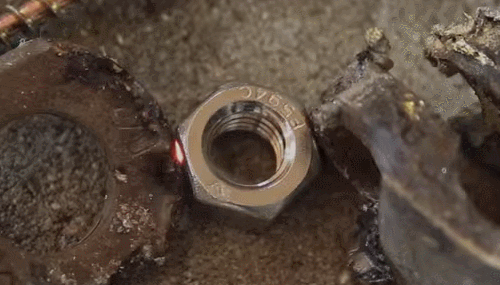
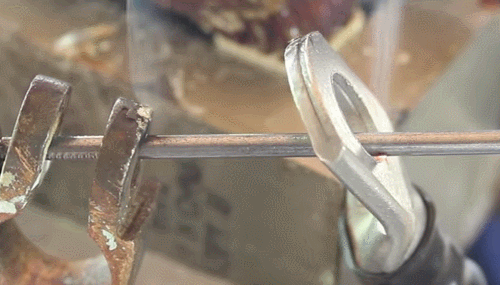
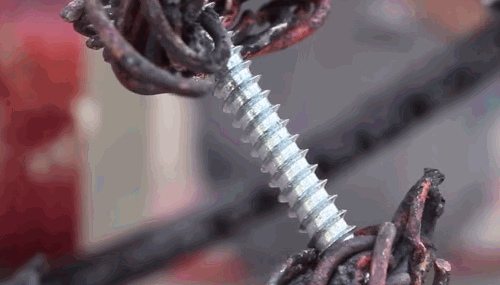
High Current/Amps through metal
Any metal that can conduct low voltage / high amperage electricity acts as a resistor between two electrode wires (as in the case above), which are made out of copper, which has a better conductivity than iron/steel which heats up due to the extreme electrical resistance.
Copper (Cu):
Resistivity: ρ(Ω·m) at 20ºC = 1.68×10−8
Conductivity: σ (S/m) at 20ºC = 5.96×107
Temp. Coefficient: 0.003862 (K−1)
Iron (Fe): (although what you see in the gif is steel, iron comes pretty close)
Resistivity: ρ(Ω m) at 20ºC = 1.00×10−7
Conductivity: σ (S/m) at 20ºC = 1.00×107
Temp. Coefficient: 0.005 (K−1)
Giffed by: rudescience From: This video
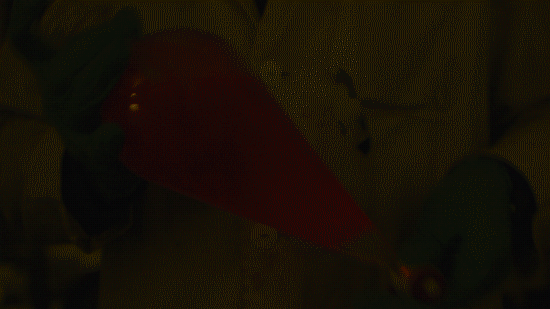
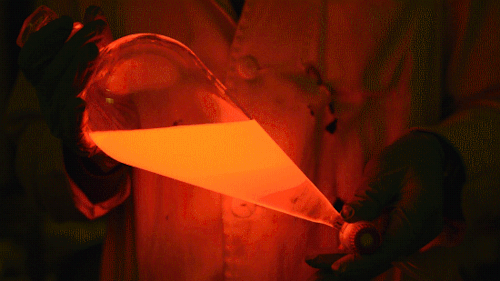
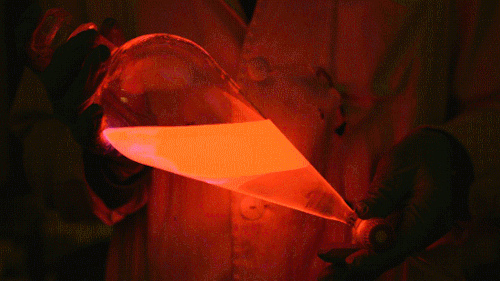
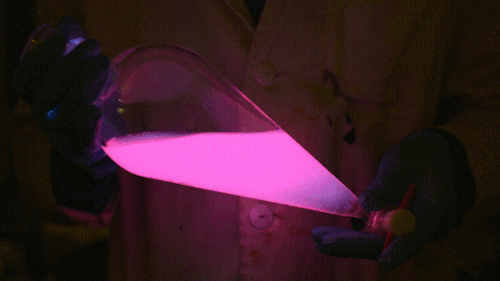
Playing with the glowstick reaction using TCPO (bis(2,4,6-trichlorophenyl) oxalate).
The glow stick contains two chemicals and a suitable dye. One of the chemicals is a diaryl oxalate (in this case TCPO, or bis(2,4,6-trichlorophenyl) oxalate), the other one is an oxidizer, usually hydrogen peroxide. By mixing the peroxide with the oxalate ester, a chemical reaction takes place, releasing energy that excites the dye, which then relaxes by releasing a photon, emitting light. The color of the emitted light depends on the structure of the dye. The chemistry behind the reaction is something like this:

During this reaction I used two type of dyes, on of them was Nile Red, what is a quite special, solvatofluorescent dye and Perylene what is a polyaromatic hydrocarbon. When used in pure form the perylene emits a bright blue light, but when its combined with Nile Red, it emits this nice pinkish-purple as seen on the gifs above and on this video:

A 25-year-old student has just come up with a way to fight drug-resistant superbugs without antibiotics.
The new approach has so far only been tested in the lab and on mice, but it could offer a potential solution to antibiotic resistance, which is now getting so bad that the United Nations recently declared it a “fundamental threat” to global health.
Antibiotic-resistant bacteria already kill around 700,000 people each year, but a recent study suggests that number could rise to around 10 million by 2050.
In addition to common hospital superbug, methicillin-resistant Staphylococcus aureus (MRSA), scientists are now also concerned that gonorrhoea is about tobecome resistant to all remaining drugs.
But Shu Lam, a 25-year-old PhD student at the University of Melbourne in Australia, has developed a star-shaped polymer that can kill six different superbug strains without antibiotics, simply by ripping apart their cell walls.
“We’ve discovered that [the polymers] actually target the bacteria and kill it in multiple ways,” Lam told Nicola Smith from The Telegraph. “One method is by physically disrupting or breaking apart the cell wall of the bacteria. This creates a lot of stress on the bacteria and causes it to start killing itself.”
The research has been published in Nature Microbiology, and according to Smith, it’s already being hailed by scientists in the field as “a breakthrough that could change the face of modern medicine”.
Before we get too carried away, it’s still very early days. So far, Lam has only tested her star-shaped polymers on six strains of drug-resistant bacteria in the lab, and on one superbug in live mice.
But in all experiments, they’ve been able to kill their targeted bacteria - and generation after generation don’t seem to develop resistance to the polymers.
Continue Reading.

On military live fire training ranges, troops practice firing artillery shells, drop bombs on old tanks or derelict buildings and test the capacity of new weapons.
But those explosives and munitions leave behind toxic compounds that have contaminated millions of acres of U.S. military bases – with an estimated cleanup bill ranging between $16 billion and $165 billion.
In a paper published online Nov. 16 in Plant Biotechnology Journal, University of Washington and University of York researchers describe new transgenic grass species that can neutralize and eradicate RDX – a toxic compound that has been widely used in explosives since World War II.
UW engineers introduced two genes from bacteria that learned to eat RDX and break it down into harmless components in two perennial grass species: switchgrass (Panicum virgatum) and creeping bentgrass (Agrostis stolonifera). The best-performing strains removed all the RDX from a simulated soil in which they were grown within less than two weeks, and they retained none of the toxic chemical in their leaves or stems.
Continue Reading.

Straight Outta Answers
-
 anandanivea liked this · 1 year ago
anandanivea liked this · 1 year ago -
 cacophonyofcolors liked this · 7 years ago
cacophonyofcolors liked this · 7 years ago -
 inspolang reblogged this · 7 years ago
inspolang reblogged this · 7 years ago -
 thesleepinghorizon liked this · 8 years ago
thesleepinghorizon liked this · 8 years ago -
 rattlingthecage liked this · 8 years ago
rattlingthecage liked this · 8 years ago -
 theperksofbeingawallfailure reblogged this · 8 years ago
theperksofbeingawallfailure reblogged this · 8 years ago -
 theperksofbeingawallfailure liked this · 8 years ago
theperksofbeingawallfailure liked this · 8 years ago -
 inkpelt reblogged this · 8 years ago
inkpelt reblogged this · 8 years ago -
 dieinaholeyoubut-blog liked this · 8 years ago
dieinaholeyoubut-blog liked this · 8 years ago -
 mal-jour liked this · 8 years ago
mal-jour liked this · 8 years ago -
 keenwanderer reblogged this · 8 years ago
keenwanderer reblogged this · 8 years ago -
 therianlycan liked this · 8 years ago
therianlycan liked this · 8 years ago -
 illturnyourtears2roses liked this · 8 years ago
illturnyourtears2roses liked this · 8 years ago -
 todd-the-foxx reblogged this · 8 years ago
todd-the-foxx reblogged this · 8 years ago -
 theinkgirl reblogged this · 8 years ago
theinkgirl reblogged this · 8 years ago -
 i-hope-they-have-wifi-in-hell liked this · 8 years ago
i-hope-they-have-wifi-in-hell liked this · 8 years ago -
 flinch-cain reblogged this · 8 years ago
flinch-cain reblogged this · 8 years ago -
 silverblue94 liked this · 8 years ago
silverblue94 liked this · 8 years ago -
 rainingrosebuds liked this · 8 years ago
rainingrosebuds liked this · 8 years ago -
 tominaservina liked this · 8 years ago
tominaservina liked this · 8 years ago -
 jakarrael liked this · 8 years ago
jakarrael liked this · 8 years ago -
 gloriousskivvies liked this · 8 years ago
gloriousskivvies liked this · 8 years ago -
 therodentqueen liked this · 8 years ago
therodentqueen liked this · 8 years ago -
 squidificati0n liked this · 8 years ago
squidificati0n liked this · 8 years ago -
 fancysaurus liked this · 8 years ago
fancysaurus liked this · 8 years ago -
 etherealgoddess reblogged this · 8 years ago
etherealgoddess reblogged this · 8 years ago -
 vixvaporub reblogged this · 8 years ago
vixvaporub reblogged this · 8 years ago -
 frisfras liked this · 8 years ago
frisfras liked this · 8 years ago -
 berserk-al liked this · 8 years ago
berserk-al liked this · 8 years ago -
 unnounblr reblogged this · 8 years ago
unnounblr reblogged this · 8 years ago -
 mybladderisabagel-deactivated-jk reblogged this · 8 years ago
mybladderisabagel-deactivated-jk reblogged this · 8 years ago -
 ggsandbees liked this · 8 years ago
ggsandbees liked this · 8 years ago -
 seliphra reblogged this · 8 years ago
seliphra reblogged this · 8 years ago
60 posts